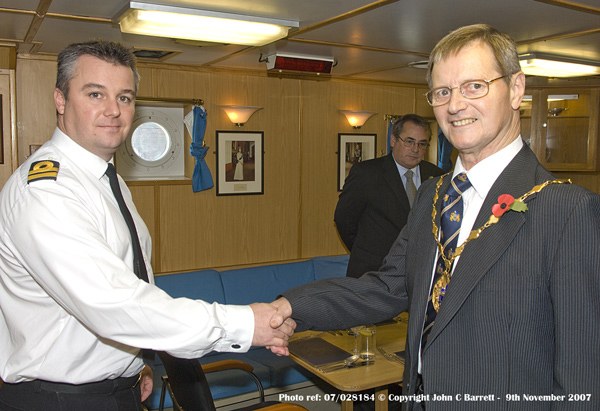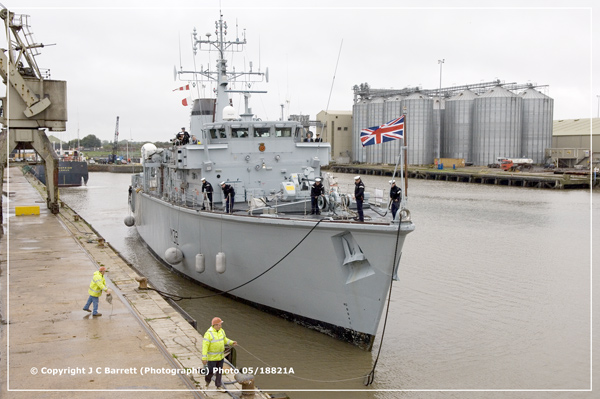Port of King's Lynn - Associated British Ports.
Unusual Visitors to the Port Page 1
Quick Links - select to view reports (Latest at top).
11. MV Baden Powell Sails out of King's Lynn Docks.
10. UKD's Sealion working in the river for KLCB. Also UKS's Dredger Cherry Sand and KLCB Pilot boat.
9. Giant Crane Barge Arrives on ABP Riverside Berth To Help Flood Defences.
8. Geoff Bullen ATC RAF died on 21st March 2014.
7. A tug from Hamburg brought the large barge into the Port of Lynn. and loaded ABP's King's Lynn largest crane a Liebherr LHM1120
6. Dutch training Schooner DE Tukker, the 100ft ship had to make an unscheduled call at the port of King's Lynn, on 31st May 2004.
5. Mosquito memorial dedication at the ATC HQ in Loke Road, King's Lynn - 2nd January 2012.
4. De Haviland Mosquito NS 988 . Parts recovered from Wash - 22nd July 2004.
3. Kieler Hansekogge Boal Quay, King's Lynn,7th August 2004.
2. H M S Cottesmore. Sunday 18th September 2005 Lynn's TS Vancover Sea Cadets visit.
1. Royal Navy mine hunter HMS Brocklesby arrived at King's Lynn on Friday 9th November 2007 to support the town's annual Remembrance Day commemorations to Remember Fallen Heroes.
VIEWING IMAGES:
Navigating from one image to the next, Pressing N moves to the next image, and P to the previous one, the same goes for the right and left arrow keys. (open No 1 first to view all)
HMS Brocklesby 9th Nov 2007
Royal Navy mine hunter HMS Brocklesby arrives in King's Lynn this Friday (9 November 2007) to support the town's annual Remembrance Day commemorations to Remember Fallen Heroes.
HMS Brocklesby is the fifth of the Royal Navy's eleven Hunt Class Mine Countermeasures Vessels(MCMVs) and is a member of the Third Mine Countermeasures Squadron based at Faslane.
HMS Brocklesby has the ability to conduct both minesweeping and minehunting operations. The addition of a 30mm gun enables HMS Brocklesby to be tasked in the role of Patrol Craft. The hull and most of the superstructure are constructed from GRP that is both non-magnetic and strong enough to withstand the explosive shocks likely to be encountered in a mine environment. The primary reason for having a GRP hull is to reduce to a minimum the ship's magnetic signature. The ship's noise signature has also been reduced to a minimum by tuning and matching all the main machinery and by taking great care with all resilient mountings.
Commanding Officer:
Lieutenant Commander Matthew Dennisis the commanding officer he was born in Lincolnshire in 1969 and joined the Britannia Royal Naval College, as a Naval College Entry, in 1989 after completing his education at Spalding Grammar School. His initial naval training was consolidated by Fleet Training in HMS Danae on a South Atlantic Deployment.
On completion of Officer Training he specialised as a Submariner and completed his initial submarine training at HMS Dolphin in 1991. His qualifying time was conducted in HMS Tireless, where he became the Casing Officer, once he had earned his "Dolphins". After a further course at HMS Dolphin he joined HMS Talent as the Communications Officer and later the Navigating Officer.
(Photograph above):Lieutenant Anthony Wallace Royal Navy - Executive Officer Right Deputy Mayor Borough Mayor for King's Lynn & West Norfolk.
After graduating from the Camborne School of Mines, Anthony joined the Royal Navy in January 2000. On completion of Initial Training and Junior Warfare Officers Course he was appointed to HMS Albion during the latter stages of build, and subsequently deployed to the Arctic and Gulf of Mexico. A short appointment to UKMARBAT staff in Bahrain followed before commencing the Mine Warfare Officer course in November 2004. On completion he joined HMS Hurworth as Operations Officer. Anthony joined HMS Brocklesby in November 2006. He is second in command onboard and one of two Mine Warfare Officers. He has responsibilities including: overseeing of all seamanship evolutions, discipline, Safety Health and Environment, Logistics Support and Whole Ship training. Anthony lives on Bodmin Moor with his wife Sarah, sons Toby (3) and Edward (1) and dog Boris.
Sunday 18th September 2005 Lynn's TS Vancover Sea Cadets visit H M S Cottesmore
H.M.S. Cottesmore
VIEWING IMAGES:
Navigating from one image to the next, Pressing N moves to the next image, and P to the previous one, the same goes for the right and left arrow keys. (open No 1 first to view all)
15th September 2005.
HMS Cottesmore (ex-minesweeper) entered The Port of King's Lynn today 15th September 2005.
Members of Lynn's TS Vancover Sea Cadets - Visited today.
LtoR: (in photograph) 1. A/C Kirsty Wenn, 2 Cdt Mulligan, 3 OC Kim Goodliffe, 4 Cdt Luke Sturgeon, 5 Cdt Hannah Allen,6 A/C Arron Grimes, 7 A/C Kirsty Griffithes, 8 A/C Tamsin Sheldrake, 9 Lt Tom Williams RN - Gunnery Officer, 10 PPO(SCC) Graham Simpson 11 Lt Cdr(SCC) Tony Norris, 12 Civilian Instructor Mrs Debbie Hannant
The vessel has maintained strong links with the residents of Cottesmore village, and is affiliated with RAF Cottesmore. The ship’s company of 36 officers and ratings will be visiting the village and airbase to say farewell to the many friends they have made, while the Commanding Officer of the ship, Lieutenant Dan Knight, will pay his respects to the Mayor of King’s Lynn and West Norfolk, Councillor Trevor Manley.
The vessel is the third Royal Naval warship to bear the name HMS Cottesmore. Constructed entirely of Glass-Reinforced Plastic, the warship – originally a mine-countermeasures vessel –was refitted for patrol duties, which included conducting boarding operations in UK waters. In support of this task, she carried a team of Royal Marines, and up to three fast boats.
This will be the last appearance before being withdrawn from service. It is visiting to keep up relations with Cottesmore near Stamford in Lincolnshire and visited King's Lynn as it's one of the closest ports to the town.
The warship will stay in port from 15th to 20th of September 2005, before sailing to Portsmouth, where she will be decommissioned.
(See photograph above) On board was Borough Mayor Mr Trevor Manley, he joined the vessel via the KLCB pilot boat earlier in the day. Lieutenant Dan Night, captain of the ship, will be visiting the Mayor in Lynn Town Hall on Friday morning. A reception will be held on board on Friday evening attended by Mr Manley and his wife Borough Mayoress Mrs Coral Manley, also invited are Group Captain Greg Bagwell from RAF Marham, West Norfolk Council leader Mr John Dobson, harbour master and chief executive of Lynn Conservancy Board, Mr John Lawkin, and deputy Port Manager Associated British Ports Mr Paul Jarvis.
HMS Cottesmore is 60 metres long and 10 metres wide. The ship was built in Glasgow, was launched in February 1982 and was first in service in June 1983.
The ship is coming out of commission, and this is the last opportunity for her to visit the town. The boat was first used as a minesweeper and was then converted to a patrol vessel. It was used to patrol UK waters and look for suspicious shipping and terrorists.
Due to the security, the vessel was not be open to the general public
VIEWING IMAGES:
Navigating from one image to the next, Pressing N moves to the next image, and P to the previous one, the same goes for the right and left arrow keys. (open No 1 first to view all)
7th August 2004 Kieler Hansekogge - Boal Quay, King's Lynn
A replica 14th century Hanseatic ship arrived at the Boal Quay, King's Lynn on 7th August 2004 staying for several days. During this time visits will be permitted for periods of about two hours either side of high tide. (Note this is NOT in the King's Lynn Dock)
Brief summary
The Hanseatic League was a federation of cities, which had developed from European merchant guilds in mediaeval Europe into an early European economic bloc. Through the late 13th and 14th centuries it became a major urban confederation of cities not only in northern Germany but extending across Scandinavia to Russia, and involving reciprocal trade agreements with cities in England, such as King's Lynn and Boston, and even in Italy. The League had enormous economic clout and had a great sway in politics and culture in Europe for centuries.
(See Photo 04/013715 above) - The League's ships plied the major trade routes across the North Sea and the Baltic, and the cog was its tramp cargo vessel. First records of the cog appear in the 10th century. Viking longships had had little space for cargo. The cog, or cogge, was rounded, tub-like, with a high clinker-planked hull, a high stern and a deck which covered a considerable hold. Early accounts indicate that it had a steering rudder on the starboard side, though by the mid 13th century this had been replaced by a stern rudder. There were eventually small raised decks at the bow and the stern.
The most famous preserved example is the Bremen Cog of 1380 which was raised from the mud in 1962. This cog is quite large - 77ft long by 23ft wide - and could have carried as much as 150 tons of cargo as well as a crew of about 18 men. It was discovered when dredging was being carried out on the River Weser. Its position suggested that it had been in construction at a shipyard when it was hit by a storm or high tide and was swept into a sandbank. Until this find the details of the cog's construction were not fully known.
The cog became the dominant ship during the rise of the Hanseatic League and in the history of the ship it is a vessel of great significance. The Bremen Cog is in the Deutsche Schiffahrmuseum in Bremerhaven.
The dimensions of the original as well as the rebuilt cog are as follows:
- Length: 23,3m
- Length of keel I5,60 m
- width: 7,6 m
- Moulded depth 3,14 m
- Mast length 25,O m
- Draught loaded 2,25 m
- Hold abt. 150 m³
- cuft Sail area abt 200 m²
The main characteristics of a cog-type ship are:
- · the bottom is carvel-planked
- · the rest of the hull is clinker-planked
- · Strong square-beams which protrude from the sides of the hull enhancing the structural strength of the ship
- · the planks are connected between themselves by iron-nails which are beaten back into the timber, thus providing a firm connection
- · one mast with one square sail
In June 1987 a scientifically exact reproduction of the 1 380-cog was laid down at the "Yacht-& Bootswerft E. Rathje" in Kiel-Friedrichsort. The ship was launched OCT 30, 1989.
The building process was managed by Uwe Baykowski, a boat-building-master, and scientifically surveyed by Dipl. Ing. W. D. Hoheisel of the "Deutsches Schifffahrts-Museum", Bremerhaven.
The "Verein Jugend in Arbeit in Kiel e. V." - an organisation aiming at qualifying young unemployed - is owner and managing authority of the "Hansekogge". This society is supported by the "Förderverein Historische Hansekogge Kiel e. V.", an association to promote the historical hanseatic cog in Kiel, which is open to individual membership.
The "Job Creation Scheme" was borne by the "Federal Labour Authority" in co-operation with the "Ministry of Social Affairs" of the State Government Schleswig-Holstein. lt aims at qualifying young people who have been out of labour over a long period, and to help them to return to regular work. This goal was achieved to a considerable degree; quite a number of the young have found a permanent job
Last  on 12 January 2021
on 12 January 2021
VIEWING IMAGES:
Navigating from one image to the next, Pressing N moves to the next image, and P to the previous one, the same goes for the right and left arrow keys. (open No 1 first to view all)


